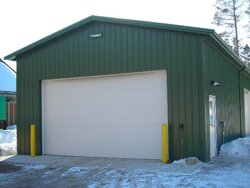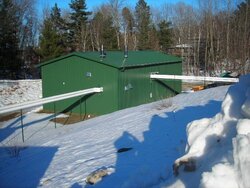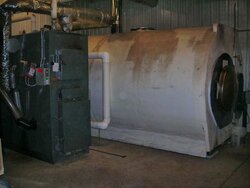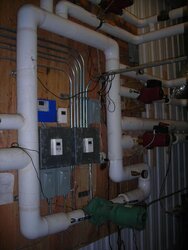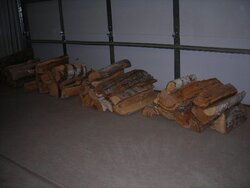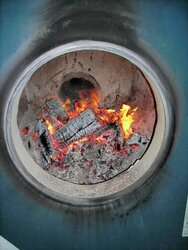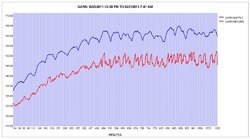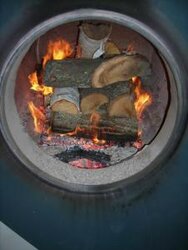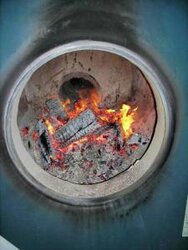Garn, continued:
As the burns progressed it became apparent that coals and ash gradually were building up in the Garn, even though I was following as best as I could Garn loading recommendations. Perhaps this was related to the quality of the fire wood, although the wood essentially was of the same mix, size, and quality as that used with the WG. Regardless, it would have been very difficult to impossible to load at a higher rate than 100 lbs per hour on a continuous basis. By the last load at 7:30 am at the end of the test burn period, and after 19 hours of continuous burn, the bed of coals and ash was above the level of the refractory lining in the bottom of the Garn firebox, and the Garn had to be allowed to burn the coals out and have ashes emptied before it could continue to be used. Other than coals and ash buildup, the Garn is a breeze to operate; just load, lock, and fire. Also a very nice boiler.
Once again, plans and real world did not match. The forecasted low outside temperatures of -5F to +15F did not materialize. Actual temperatures were 19-20F during the first six hours of burn, then gradual falling temperature to a low of 10F at 6:30 am. I really wanted outside temperature at least down to 0F, like it was for the Wood Gun, to get a side-by-side comparison. It was not to happen.
Interesting results. First the easy and not too technical results; then more detail.
A. Burn Rate. Garn BTUh input during the test burn is estimated at 600,500. As mentioned above, I don't think I could have maintained a continuous burn rate higher than 600,500 BTUh due to coals and ash build-up, and therefore, I doubt that the advertised 925,000 BTUh burn rate can be maintained other than over a fairly short period of time, after which the coals will need to be allowed to burn down and ash emptied. My 19 hour continuous burn was about the limit for the Garn. Therefor, if the need is for continuous output, like Deep Portage requires, a boiler 1) will have to be substantially over-sized and with sufficient storage to carry the load until the boiler burns down, ash emptied, and the boiler re-fired; 2) a supplemental heat source will be needed during the down time; or, 3) the boiler needs to be of a design that allows long term, continuous operation. Yet, I believe every wood boiler at particular times will need to be shut down for cleaning and/or ash emptying; the questions will be how frequently this needs to be done and what will handle the heat load during the down time.
B. Garn Temperature. The Garn analog temperature gauge on the front started at 130F at 12:30 pm (outside temp of 19F), rose to 153F by 9:30 pm (outside temp of 15F), held at 153F until 12:30 am (outside temp of 12F), and then rose and essentially held at 156F, with one downward bounce to 152F, until 7:30 am (outside temp of 11F). It appears that at the 100 lb - 600,500 BTUh burn rate, the Garn had maxed out its ability to provide BTU's to the Deep Portage system based on the demand during this period and outside temperature of about 10-11F. (I wish the WG burn had concluded successfully, because variables affecting the results would have been very close to those prevailing during the Garn burn, although temperature dropped to 0F for the WF, and a side-by-side comparison could have been made.)
C. BTU Input. Beginning at 12:30 pm on February 20 and ending with the last load at 6:30 am February 21, the Garn burned 1,858 lbs of wood, which at 6,050 BTU/lb amounts to 11,240,900 BTU input. Starting tank temperature was 130F, ending tank temperature was 156F, for a 26F temperature rise. I will account for this when calculating BTU output.
D. BTU Output. I had Dallas 1-wire DS18b20 sensors on the Garn supply to the heat exchanger and Garn return from the heat exchanger. This data showing delta-T along with calculated flow rate, and adjusted for the increase in tank temperature, will show BTU output. Similar sensors were on the heat exchanger supply to the system and system return. That information is not directly relevant to Garn performance. Suffice it to say that the heat exchanger is generously sized and has an approach temperature of about 5F (example: Garn supply to HX = 150F, HX supply to system = 145F). The chart which follows shows Garn supply to HX and HX return to Garn. See error correction a couple of posts down From the data underlying this chart, I averaged delta-T, which was 9.72F degrees. Flow rate is calculated at 75 gpm. BTUh = 9.72 x 500 x 8.34 = 364,500. Total hours = 19. For the 19 hour period, total BTU output was 6,925,500.
E. Efficiency. Based on BTU input of 11,240,900, BTU output of 6,925,500, and BTU’s stored in the rise in tank temp from 130 to 156F of 693,888, efficiency can be calculated by BTU Output / BTU Input, which is (6,925,500 + 693,888) / 11,240,900 = 67.8%. Efficiency is 86%; see error correction a couple of posts down. A further adjustment, which I doubt is material, is to account for low coals at the beginning of the burn period and low burn, high coals at the end of the burn. Regardless, I don’t think the leftover coals should be accounted for because little if any useful heat was being provided and the Garn had to be allowed to burn out to allow for ash removal.
Eye Candy
Following are several pictures which show the Deep Portage boiler room/wood staging area, along with a picture of one very tired boiler operator after an all-nighter.
Comments, reflections, observations are appreciated.
Continues in Part 3
See also Part 1
As the burns progressed it became apparent that coals and ash gradually were building up in the Garn, even though I was following as best as I could Garn loading recommendations. Perhaps this was related to the quality of the fire wood, although the wood essentially was of the same mix, size, and quality as that used with the WG. Regardless, it would have been very difficult to impossible to load at a higher rate than 100 lbs per hour on a continuous basis. By the last load at 7:30 am at the end of the test burn period, and after 19 hours of continuous burn, the bed of coals and ash was above the level of the refractory lining in the bottom of the Garn firebox, and the Garn had to be allowed to burn the coals out and have ashes emptied before it could continue to be used. Other than coals and ash buildup, the Garn is a breeze to operate; just load, lock, and fire. Also a very nice boiler.
Once again, plans and real world did not match. The forecasted low outside temperatures of -5F to +15F did not materialize. Actual temperatures were 19-20F during the first six hours of burn, then gradual falling temperature to a low of 10F at 6:30 am. I really wanted outside temperature at least down to 0F, like it was for the Wood Gun, to get a side-by-side comparison. It was not to happen.
Interesting results. First the easy and not too technical results; then more detail.
A. Burn Rate. Garn BTUh input during the test burn is estimated at 600,500. As mentioned above, I don't think I could have maintained a continuous burn rate higher than 600,500 BTUh due to coals and ash build-up, and therefore, I doubt that the advertised 925,000 BTUh burn rate can be maintained other than over a fairly short period of time, after which the coals will need to be allowed to burn down and ash emptied. My 19 hour continuous burn was about the limit for the Garn. Therefor, if the need is for continuous output, like Deep Portage requires, a boiler 1) will have to be substantially over-sized and with sufficient storage to carry the load until the boiler burns down, ash emptied, and the boiler re-fired; 2) a supplemental heat source will be needed during the down time; or, 3) the boiler needs to be of a design that allows long term, continuous operation. Yet, I believe every wood boiler at particular times will need to be shut down for cleaning and/or ash emptying; the questions will be how frequently this needs to be done and what will handle the heat load during the down time.
B. Garn Temperature. The Garn analog temperature gauge on the front started at 130F at 12:30 pm (outside temp of 19F), rose to 153F by 9:30 pm (outside temp of 15F), held at 153F until 12:30 am (outside temp of 12F), and then rose and essentially held at 156F, with one downward bounce to 152F, until 7:30 am (outside temp of 11F). It appears that at the 100 lb - 600,500 BTUh burn rate, the Garn had maxed out its ability to provide BTU's to the Deep Portage system based on the demand during this period and outside temperature of about 10-11F. (I wish the WG burn had concluded successfully, because variables affecting the results would have been very close to those prevailing during the Garn burn, although temperature dropped to 0F for the WF, and a side-by-side comparison could have been made.)
C. BTU Input. Beginning at 12:30 pm on February 20 and ending with the last load at 6:30 am February 21, the Garn burned 1,858 lbs of wood, which at 6,050 BTU/lb amounts to 11,240,900 BTU input. Starting tank temperature was 130F, ending tank temperature was 156F, for a 26F temperature rise. I will account for this when calculating BTU output.
D. BTU Output. I had Dallas 1-wire DS18b20 sensors on the Garn supply to the heat exchanger and Garn return from the heat exchanger. This data showing delta-T along with calculated flow rate, and adjusted for the increase in tank temperature, will show BTU output. Similar sensors were on the heat exchanger supply to the system and system return. That information is not directly relevant to Garn performance. Suffice it to say that the heat exchanger is generously sized and has an approach temperature of about 5F (example: Garn supply to HX = 150F, HX supply to system = 145F). The chart which follows shows Garn supply to HX and HX return to Garn. See error correction a couple of posts down From the data underlying this chart, I averaged delta-T, which was 9.72F degrees. Flow rate is calculated at 75 gpm. BTUh = 9.72 x 500 x 8.34 = 364,500. Total hours = 19. For the 19 hour period, total BTU output was 6,925,500.
E. Efficiency. Based on BTU input of 11,240,900, BTU output of 6,925,500, and BTU’s stored in the rise in tank temp from 130 to 156F of 693,888, efficiency can be calculated by BTU Output / BTU Input, which is (6,925,500 + 693,888) / 11,240,900 = 67.8%. Efficiency is 86%; see error correction a couple of posts down. A further adjustment, which I doubt is material, is to account for low coals at the beginning of the burn period and low burn, high coals at the end of the burn. Regardless, I don’t think the leftover coals should be accounted for because little if any useful heat was being provided and the Garn had to be allowed to burn out to allow for ash removal.
Eye Candy
Following are several pictures which show the Deep Portage boiler room/wood staging area, along with a picture of one very tired boiler operator after an all-nighter.
Comments, reflections, observations are appreciated.
Continues in Part 3
See also Part 1


